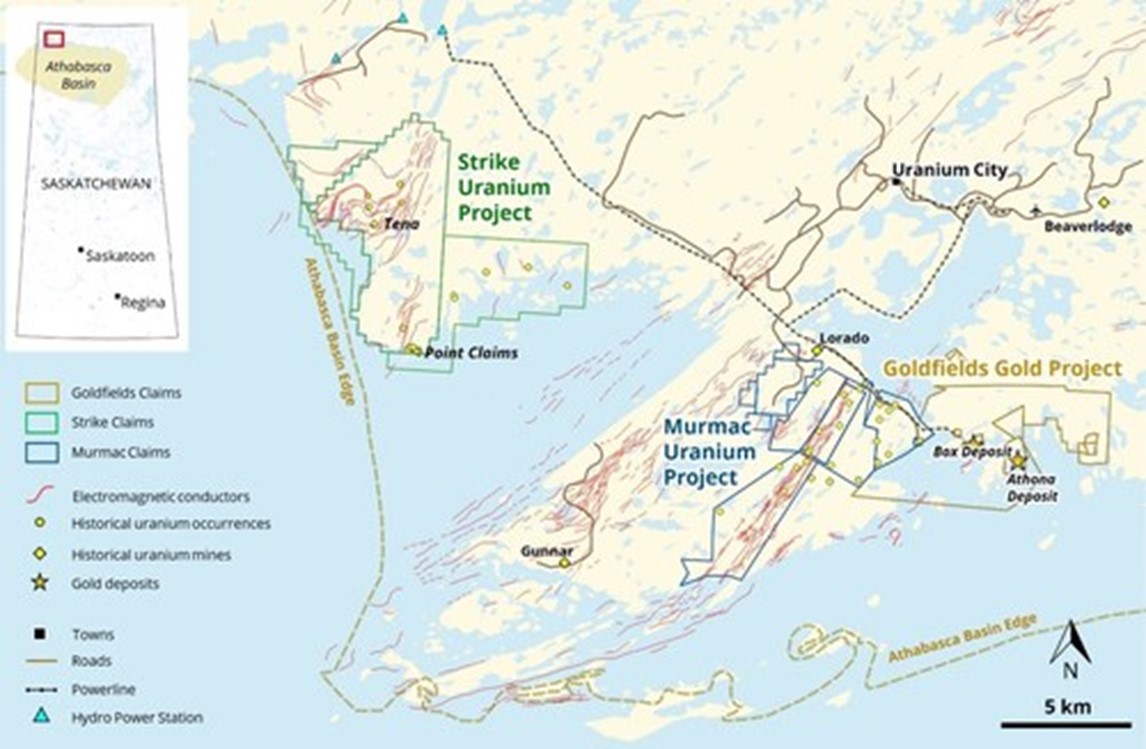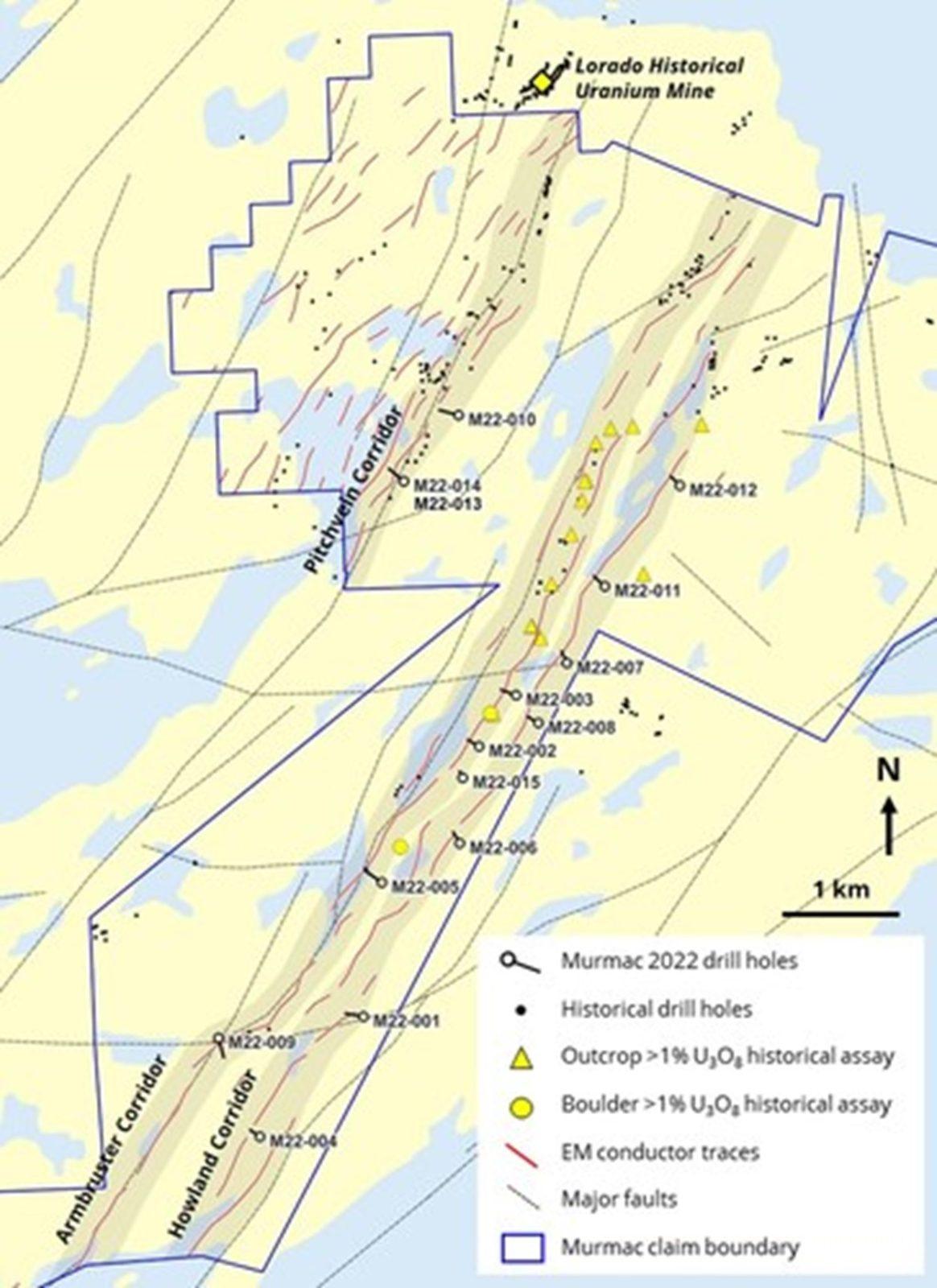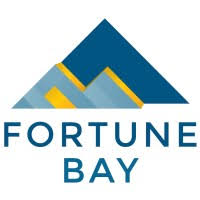
FORTUNE BAY CONFIRMS NEAR-SURFACE URANIUM MINERALIZATION IN MULTIPLE DRILL HOLES ON THE MURMAC URANIUM PROJECT
Fortune Bay Corp. (TSX-V: FOR) (FWB: 5QN) (OTCQX: FTBYF) is pleased to announce analytical results from its maiden exploration drilling program on the 100% owned Murmac Uranium Project, located in northern Saskatchewan (see Figure 1).
The drilling program was designed to test regional targets across the Project’s extensive Armbruster, Howland and Pitchvein Conductor Corridors, which have a combined strike length of approximately 30 kilometres.
Shallow, highly elevated concentrations of uranium were confirmed in six (6) of the fifteen (15) drill holes, including 0.18% U3O8 and 0.17% U3O8 from individual assay samples.
The uranium is associated with anomalous levels of “pathfinder” elements that are typically associated with high-grade, basement-hosted deposits in the Athabasca Basin.
Results include shallow intersections derived from between 20 and 150 metres below surface within prospective graphitic units associated with favourable structure and alteration.
Dale Verran, CEO for Fortune Bay, commented “We are pleased to have intersected uranium in our first drilling campaign at Murmac. The results indicate we are exploring fertile corridors for high-grade uranium deposits and provide some immediate areas for priority follow-up. The shallow nature of the uranium encountered, and proximity to infrastructure within a historical uranium mining area, makes for a compelling exploration scenario. Planning is underway for a drilling program in 2023 to provide follow-up of these results and continued testing of the corridors on the Project.”
Highlights:
- Drill hole M22-002 (target A6) intersected 0.18% U3O8 from 82.0 to 82.1 metres (approximately 63 metres below surface), with the interval from 82.0 to 82.3 metres averaging 899 ppm U.
- Drill hole M22-012 (target H11) intersected 0.17% U3O8 from 102.2 to 102.3 metres (approximately 72 metres below surface), with the interval from 102.1 to 102.3 metres averaging 646 ppm U.
- Drill hole M22-013 (target P1) intersected intermittent intervals of anomalous uranium, including 347 ppm U from 30.8 to 31.4 metres, 205 ppm U from 35.9 to 36.9 metres, and 448 ppm U from 44.2 to 44.5 metres. These intervals occur over a broad 13 metre zone from approximately 29 to 42 metres below surface.
- Drill hole M22-014 (target P1) intersected an average of 241 ppm U over 3.0 metres from 36.9 to 39.9 metres (approximately 20 metres below surface).
- Drill hole M22-015 (target A10) intersected a maximum of 0.12% U3O8 from 158.2 to 158.3 metres (approximately 87 metres below surface), with the interval from 158.1 to 158.3 metres averaging 503 ppm U. The interval 161.2 to 161.5 metres averaged 122 ppm U. The interval 163.3 to 163.8 metres averaged 219 ppm U.
Analytical Results
A total of 15 drill holes (3,168 metres) were completed along the Pitchvein, Armbruster, and Howland Corridors on the Murmac Uranium Project, as announced in the News Release dated August 23, 2022. Drill hole locations are shown in Figure 2.
Anomalous uranium (>100 ppm) was encountered along all three of the corridors tested. The drill holes listed in Table 1 intersected shallow, anomalous uranium with pathfinder element enrichment typically associated with high-grade basement-hosted deposits of the Athabasca Basin. These anomalies are found in host rocks including thick and strongly graphitic units often in contact with quartzites, providing favorable competency/rheological contrast. Brittle faulting and brecciation were observed within or proximal to the graphitic units and were typically associated with favorable hydrothermal alteration including abundant hematite, chlorite, sulphides, clays and/or bleaching.
Clay species identification on drill core samples has confirmed the presence of favorable clay alteration associated with uranium and pathfinder enrichment (Table 1). Chlorite and illite occur as the dominant clay species with intermittent occurrences of kaolinite. Dravite (an encouraging clay indicator) is present in M22–012, associated with anomalous uranium at 146.5 metres. Dravite, associated with elevated boron (up to 1,170 ppm) is present in M22-009, which targeted the intersection of the Armbruster Conductor with a major cross-cutting fault (Heatherington Fault).
A summary of anomalous uranium encountered is provided in Table 1, with descriptions of pathfinder element associations and relevant lithological, structural and alteration features.
Table 1: Summary of anomalous (>100 ppm) uranium intersections.
| Target | Hole ID | From (m) |
To
(m) |
U
(ppm) |
U3O8 (wt %) |
Associated Pathfinders |
Description | |
| A6 | M22-002 | 81.2 | 82.7 | 206 | B, Cu, Pb, Zn, Ag | Foliated and fractured graphitic pelite, below the contact with overlying quartzite. Associated with hematization, chlorite alteration, graphitic shearing and faulting. | ||
| incl. | 82.0 | 82.3 | 899 | |||||
| incl. | 82.0 | 82.1 | 1,520 | 0.18 | ||||
| 91.0 | 91.1 | 208 | Pb, Co, As, Zn, Ag | |||||
| H1 | M22-004 | 82.9 | 83.0 | 209 | – | Hosted in chlorite-altered graphitic pelite, proximal to a graphitic fault. | ||
| H11 | M22-012 | 102.1 | 102.3 | 646 | Pb, As, Co, Cu | Within graphitic pelite in a hematized graphitic shear / breccia zone. | ||
| incl. | 102.2 | 102.3 | 1,150 | 0.17 | ||||
| 146.3 | 146.5 | 115 | V | Massive hematized gabbro at contact with underlying hematized pelite with localized faulting. Clay analysis confirms the presence of dravite. | ||||
| P1 | M22-013 | 25.2 | 26.0 | 133 | V, B, Cu | Anomalous U within graphitic pelite characterized by patchy hematization, chloritic shears, pyrite, local quartz flooding and disseminated sericite. Bleaching and clay alteration continues below zone of anomalous U. Drill hole located approximately 225 m SW (along strike) of mineralized intersections from historical core holes, including 1.01% U3O8 over 2.0 m (56.0 to 58.0 m in drill hole CKI-9) and 2.19% U3O8 over 0.5 m (68.0 to 68.5 m in drill hole CKI-10). |
||
| 30.8 | 31.4 | 347 | B, V | |||||
| incl. | 30.8 | 30.9 | 653 | |||||
| 35.9 | 36.9 | 205 | B, V | |||||
| 44.2 | 44.5 | 448 | B, V | |||||
| 57.4 | 58.0 | 135 | V | |||||
| 59.0 | 59.3 | 110 | – | |||||
| 60.0 | 60.5 | 104 | B, V | |||||
| 64.0 | 64.2 | 108 | B | |||||
| 67.6 | 67.9 | 163 | V, Zn | |||||
| 226.2 | 227.3 | 121 | V, Cu | Apparent association with vuggy texture in psammite with bleaching, hematization, chloritization and elevated pyrite content. | ||||
| P1 | M22-014 | 36.9 | 39.9 | 241 | V, Cu, Zn, Co, Ni, Pb | Locally brecciated graphitic pelite with increased sulphide content and chloritic shearing. Designed as a follow-up hole testing the inferred down-dip projection approximately 25 m from shallow elevated radioactivity intersected in M22-013. | ||
| incl. | 39.4 | 39.7 | 682 | |||||
| 47.8 | 48.0 | 360 | V, Mo, Co, Pb | |||||
| A10 | M22-015 | 158.1 | 158.3 | 503 | V, Zn, Pb, As, Cu | Graphitic pelite, apparent association between elevated U and shears and fractures, with bleaching and hematization. | ||
| incl. | 158.2 | 158.3 | 886 | 0.12 | ||||
| 161.2 | 161.5 | 122 | – | |||||
| 163.3 | 163.8 | 219 | V, B, Cu, As, Co, Ag, Bi |
Notes:
- Uranium and pathfinder element concentrations are shown in parts per million as determined through partial digest ICP–OES or ICP-MS analysis on all samples, as described in the technical disclosure below.
- Uranium content as weight % U3O8 was determined through HCl:HNO3 digestion and ICP-OES analysis on selected samples.
- Thresholds for pathfinder anomalism were assigned based on a combination of statistical analysis of the dataset and appropriate reference databases. Element abundances were considered elevated at the following thresholds: B>200 ppm, Pb>20 ppm, Ni>80 ppm, Co>25 ppm, As>15 ppm, Cu>40 ppm, V>75 ppm, Mo>5 ppm, Zn>75 ppm, Ag>0.2 ppm and Bi>0.75 ppm.
- True thicknesses of the drill core intersections are yet to be determined.
- Target prefixes A, H and P refer to the Armbruster, Howland and Pitchvein Conductors, respectively.
- Further drill hole details were provided in the News Release dated August 23, 2022.
Technical Disclosure
All drilling was carried out with NQ or NQ2 diameter core. The oriented drill cores have been subjected to comprehensive logging and sampling to characterize mineralization, alteration and structure. Sample intervals ranged from 10 to 50 cm. Half-split drill core samples were submitted to the Saskatchewan Research Council (“SRC”) Geoanalytical Laboratories (ISO/IEC 17025:2005 accredited) for uranium assay and multi-element characterization. Sample preparation for all samples included drying, jaw crushing to 60% passing -2 mm, and pulverizing to 90% passing -106 microns. Multi-element characterization was carried out by partial digestion (HNO3:HCl), using ICP-OES and ICP-MS analytical methods. For selected samples U3O8 weight % was determined separately through partial digest (HCl:HNO3) and ICP-OES (ISO/IEC 17025 accredited method). Additional analysis for boron content was obtained for all samples through Na2O2/NaCO3 fusion followed by ICP-OES.
Clay species identification through short-wave infrared (SWIR) spectroscopy was carried out on drill chips at regular spacing (between 6 and 9 m) down the full length of each drill hole. An Integrated Spectronics Ltd. Portable Infrared Mineral Analyser (PIMA-II) was used to acquire spectral measurements in the wavelength range from 1250 to 2500 nm. Mineral identification using SWIR spectroscopy is based on both the position and shape of individual absorption peaks, and the shape of the overall spectrum. These characteristics were compared to reference spectra (such as SPECMINTM library) provided for a variety of minerals detectable in the SWIR region of the electromagnetic spectrum.
Qualified Person and Data Quality
The technical and scientific information in this news release has been reviewed and approved by Dale Verran, M.Sc., P.Geo., Chief Executive Officer of the Company, who is a Qualified Person as defined by NI 43-101. Mr. Verran is an employee of Fortune Bay and is not independent of the Company under NI 43-101.
Unless otherwise stated, the historical results (scintillometer measurements, geochemical analysis and drill results) contained within this news release have not been verified and there is a risk that any future confirmation work and exploration may produce results that substantially differ from the historical results. The Company considers these results relevant to assess the mineralization and economic potential of the property. The historical drill results obtained by SMDC in drill holes CKI-9 and CKI-10 (Table 1) can be found within the Saskatchewan Mineral Assessment Database (SMAD) references 74N07-0310 and 74N07-0311. Assay and scintillometer survey results from SMDC (Figure 2) were captured from tables and georeferenced figures in these assessment reports.
About Fortune Bay
Fortune Bay Corp. is an exploration and development company with 100% ownership in two advanced gold exploration projects in Canada, Saskatchewan (Goldfields Project) and Mexico, Chiapas (Ixhuatán Project), both with exploration and development potential. The Company is also advancing the 100% owned Strike and Murmac uranium exploration projects, located near the Goldfields Project, which have high-grade potential typical of the Athabasca Basin. The Company has a goal of building a mid-tier exploration and development Company through the advancement of its existing projects and the strategic acquisition of new projects to create a pipeline of growth opportunities. The Company’s corporate strategy is driven by a Board and Management team with a proven track record of discovery, project development and value creation.

Figure 1: Location of Fortune Bay’s Murmac, Strike and Goldfields Projects. (CNW Group/Fortune Bay Corp.)

Figure 2: Location of the 2022 drill holes completed on the Murmac Uranium Project. (CNW Group/Fortune Bay Corp.)
MORE or "UNCATEGORIZED"
Kuya Silver Confirms High-Grade Silver-Gold Vein Mineralization at Umm-Hadid with Initial Drill Results up to 1483.9 g/t AgEq over 2 Metres
Kuya Silver Corporation (CSE: KUYA) (OTCQB: KUYAF) (FSE: 6MR1) is... READ MORE
First Phosphate Closes Final Tranche of Oversubscribed Private Placement
First Phosphate Corp. (CSE: PHOS) (OTCQX: FRSPF) (FSE: KD0) is... READ MORE
GFG Receives Final Payment from the Sale of its Rattlesnake Hills Gold Project
GFG Resources Inc. (TSX-V: GFG) (OTCQB: GFGSF) announces that i... READ MORE
Goliath Receives $1,730,882 Through Warrant Exercises, Inclusive Of Crescat Capital A Longtime Strategic And Cornerstone Shareholder
Goliath Resources Limited (TSX-V: GOT) (OTCQB: GOTRF) (FSE: B4IF)... READ MORE
Robex Pours First Gold at Kiniéro on Schedule and Budget
Highlights: Gold bar weighing 2.64 kilograms (85 oz) poured in th... READ MORE













